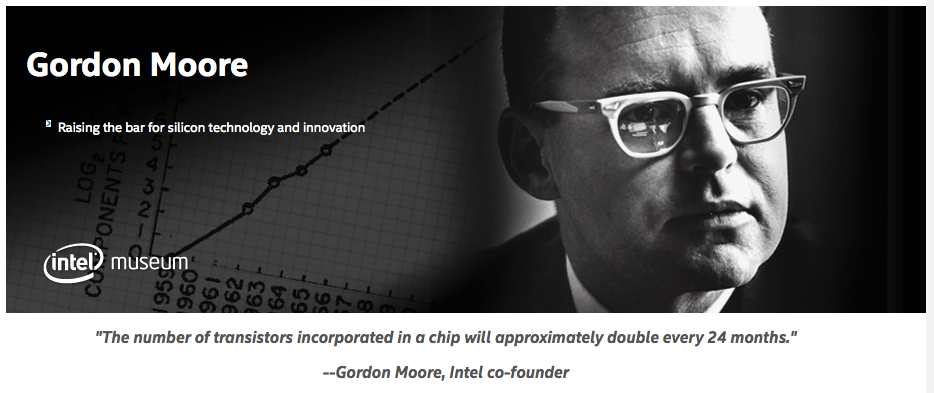
Listen to Larry Magid’s 2005 interview with Gordon Moore recorded on the 40th anniversary of Moore’s Law
This post is adapted from one that first appeared on CBSNews.com on April 18, 2005
On April 19, 1965 Fairchild Semiconductor Founder Gordon Moore, who went on to co-found Intel, wrote a magazine article in which he observed that the number of components on a microprocessor would double every year for the next ten years. Later he revised it to every two years and then every 18 months. That observation, that later came to be known as “Moore’s Law,” has stood the test of time. Moore’s Law turns 50 on Sunday, April 19th, 2015.
That same article also predicted the home computer, automatic controls for automobiles and “personal portable communications equipment,” (i.e. the cell phone). All of that and more have come to fruition, in no small part because of the efforts of Moore and his Fairchild colleagues Robert Noyce and Andy Grove who, in 1968, co-founded Intel.
“Integrated circuits will lead to such wonders as home computers or at least terminals connected to a central computer automatic controls for automobiles, and personal portable communications equipment. The electronic wrist-watch needs only a display to be feasible today.” — from Gordon Moore’s 1965 article

My interview with Gordon Moore
Intel’s PR department told me that Moore, 86, isn’t doing interviews for the 50th anniversary but I did get an exclusive interview with him 10 years ago on the 40th anniversary of Moore’s law. (Scroll to top of this page to listen)
Moore said that his interest in science and technology began early in life. Moore, who grew up in Pescadero, California got hold of a chemistry set when he was 11.
Explosives
“In those days you could get some good chemicals, from a boy’s point of view. You could make explosives and such. I used to turn out small production quantities of nitroglycerin and make my own dynamite.” Kids doing that today would probably get a visit from Homeland Security. Moore parlayed his interest in tinkering with chemicals into a Ph.D. in Chemistry and Physics from Caltech.
In a highly technical 1965 article that appeared on page 114 of the now defunct Electronics magazine, Moore wrote “The complexity for minimum component costs has increased at a rate of roughly a factor of two per year. Certainly over the short term this rate can be expected to continue, if not to increase. Over the longer term, the rate of increase is a bit more uncertain, although there is no reason to believe it will not remain nearly constant for at least 10 years.”
When he and I spoke 10 years ago, he recalled his observation: “As we made circuits more complex we were going to make electronics a lot cheaper. So I made a wild extrapolation that the complexity of integrated circuits over the following 10 years would grow from about 60 that we were hoping to do in 1965 to something like 60,000 in 1975 and it turned out to be much more accurate that it had any reason to be when I made the prediction.”
What’s interesting about his prediction is that it holds true even as technology evolves.”The factors really relate to the technology below the level of the kind of circuitry we use. It relates to the dimensions that we can print on the circuits and the size chips we can make … I guess that’s kind of a lucky break from my point of view,” he laughed.
Moore’s law is not just an observation. It also has predictive ability. Engineers and others responsible for the design of products are able to take the law into account as they start the design process. Since it often takes years to bring a product into the world, it’s useful to have a sense of the microprocessor evolution curve before you start. That way, you can guess where the target will have moved to by the time the product is ready to go into production.
“All the participants in the industry now realize that unless they move that fast they fall behind,” Moore observed. He further noted “the peculiar thing about the semi-conductor technology as you go to these next generations … everything gets better, it’s not really an engineering trade-off. The transistors get faster, systems get more reliable and the electronics get very much less expensive. As a result any company that doesn’t heed Moore’s law will “not only have a performance disadvantage (but) have a cost disadvantage.”
Saying that costs go down is very much of an understatement. In the early sixties, a transistor cost about $5. Today a transistor costs about a millionth of a penny. “When the first integrated circuits came out their cost was such that they were really only useful in military systems. That was the only sufficiently cost insensitive application we could find,” he said.
Moore hasn’t always been so sure of that is observations about technology evolution would continue to remain true. “In looking out a few generations there always seems to be an impenetrable wall that was going to stop the rate of progress,” but things always seem to work out. “Every time we’ve come to one of those, the engineers have found a way around it. That to me is amazing.”